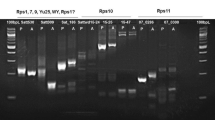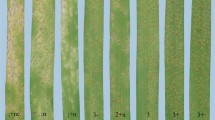Abstract
Genes at the Rp1 rust resistance locus of maize confer race-specific resistance to the common rust fungus Puccinia sorghi. Three variant genes with nonspecific effects (HRp1 -Kr1N, -D*21 and -MD*19) were found to be generated by intragenic crossing over within the LRR region. The LRR region of most NBS-LRR encoding genes is quite variable and codes for one of the regions in resistance gene proteins that controls specificity. Sequence comparisons demonstrated that the Rp1-Kr1N recombinant gene was identical to the N-terminus of the rp1-kp2 gene and C-terminus of another gene from its HRp1-K grandparent. The Rp1-D*21 recombinant gene consists of the N-terminus of the rp1-dp2 gene and C-terminus of the Rp1-D gene from the parental haplotype. Similarly, a recombinant gene from the Rp1-MD*19 haplotype has the N-terminus of an rp1 gene from the HRp1-M parent and C-terminus of the rp1-D19 gene from the HRp1-D parent. The recombinant Rp1 -Kr1N, -D*21 and -MD*19 genes activated defense responses in the absence of their AVR proteins triggering HR (hypersensitive response) in the absence of the pathogen. The results indicate that the frequent intragenic recombination events that occur in the Rp1 gene cluster not only recombine the genes into novel haplotypes, but also create genes with nonspecific effects. Some of these may contribute to nonspecific quantitative resistance but others have severe consequences for the fitness of the plant.






Similar content being viewed by others
References
Altpeter F, Vasil V, Srivastava V, Stoger E, Vasil IK (1996) Accelerated production of transgenic wheat (Triticum aestivum L.) plants. Plant Cell Rep 16:12–17
Armstrong CL, Green CE (1985) Establishment and maintenance of friable embryonic maize callus and the involvement of l-proline. Planta 164:207–217
Ayliffe MA, Steinau M, Park RF, Rooke L, Pacheco MG, Hulbert SH, Trick HN, Pryor AJ (2004) Aberrant mRNA processing of the maize Rp1-D rust resistance gene in wheat and barley. Mol Plant Microbe Interact 17:853–864
Baker B, Zambryski P, Staskawicz B, Dinesh-Kumar SP (1997) Signaling in plant–microbe interactions. Science 276:726–733
Belkhadir Y, Nimchuk Z, Hubert DA, Mackey D, Dangl JL (2004a) Arabidopsis RIN4 negatively regulate disease resistance mediated by RPS2 and RPM1 downstream or independent of NDR1 signal modulator and is not required for the virulence functions of bacterial type III effectors AvrRp12 or AvrRpm1. Plant Cell 16:2822–2835
Belkhadir Y, Subramaniam R, Dangl JL (2004b) Plant disease resistance protein signaling: NBS-LRR proteins and their partners. Curr Opin Plant Biol 7:391–399
Bendahmane A, Farnham G, Moffett P, Baulcombe DC (2002) Constitutive gain-of- function mutants in a nucleotide binding site-leucine rich repeat protein encoded at the Rx locus of potato. Plant J 32:195–204
Bozkurt O, Hakki EE, Akkaya MS (2007) Isolation and sequence analysis of wheat NBS-LRR type disease resistance gene analogs using degenerate PCR primers. Biochem Genet 45:469–486
Brueggeman R, Rostoks N, Kudrna D, Kilian A, Han F, Chen J, Druka A, Steffenson B, Keinhofs A (2002) The barley stem rust-resistance gene Rpg1 is a novel disease-resistance gene with homology to receptor kinases. Proc Natl Acad Sci 99:9328–9333
Chern M, Fitzgerald HA, Canlas PE, Navarre D, Ronald PC (2005) Overexpression of a rice NPR1 homolog leads to constitutive activation of defense response and hypersensitivity to light. Mol Plant Microbe Interact 18:511–520
Christensen AH, Sharrock RA, Quail PH (1992) Maize polyubiquitin genes: structure, thermal perturbation of expression and transcription splicing, and promoter activity following transferred protoplasts by electroporation. Plant Mol Biol 18:675–689
Collins N, Drake J, Ayliffe M, Sun Q, Ellis J, Hulbert S, Pryor T (1999) Molecular characterization of the maize Rp1-D rust resistance haplotype and its mutants. Plant Cell 11:1365–1376
Dietrich RA, Delaney TP, Uknes SJ, Ward ER, Ryals JA, Dangl JL (1994) Arabidopsis mutants simulating disease resistance response. Cell 77:565–577
Dodds PN, Schwechheiner C (2002) A breakdown in defense signaling. Plant Cell 14(Suppl):S5–S8
Ellis JG, Lawrence GJ, Luck JE, Dodds PN (1999) Identification of regions in alleles of the flax rust resistance gene L that determine differences in gene-for-gene specificity. Plant Cell 11:495–506
Ellis JG, Dodds PN, Lawrence GJ (2007) Flax rust resistance gene specificity is based on direct resistance-avirulence protein interactions. Annu Rev Phytopathol 45:289–306
Finer JJ, McMullen MD (1991) Transformation of soybean via particle bombardment of embryogenic suspension culture tissue. In Vitro Cell Dev Biol 27P:175–182
Fromm ME, Morrish F, Armstrong C, Williams R, Thomas J, Klein TM (1990) Inheritance and expression of chimeric genes in the progeny of transgenic maize plants. Bio/Tech 8:833–839
Frost D, Way H, Howles P, Luck J, Manners J, Harham A, Finnegan J, Ellis J (2004) Tobacco transgenic for the flax rust resistance gene L expresses allele-specific activation of defense responses. Mol Plant Microbe Interact 17:224–232
Fu D, Uauy C, Distelfeld A, Blechl A, Epstein L, Chen X, Sela H, Fahima T, Dubcovsky J (2009) A kinase-START gene confers temperature-dependent resistance to wheat stripe rust. Science 323:1357–1360
Greenberg J, Guo A, Klessig DF, Ausubel FM (1994) Programmed cell death in plants: a pathogen-triggered response activated coordinately with multiple defense functions. Cell 77:551–563
Hooker AL (1967) The genetics and expression of resistance in plants to rusts of the genus Puccinia. Annu Rev Phytopathol 5:163–182
Howles P, Lawrence G, Finnegan J, McFadden H, Ayliffe M, Dodds P, Ellis J (2005) Autoactive alleles of the flax L6 rust resistance gene induce non-race-specific rust resistance associated with the hypersensitive response. Mol Plant Microbe Interact 18(18):570–582
Hu G, Richter T, Hulbert S, Pryor A (1996) Disease lesion mimicry caused by mutations at the rust resistance gene Rp1. Plant Cell 8:1367–1376
Hu G, Webb CA, Hulbert SH (1997) Adult plant phenotype of the Rp1-DJ compound rust resistance gene in maize. Phytopathology 87:236–241
Hwang C-F, Williamson VM (2003) Leucine-rich repeat-mediated intramolecular interactions in nematode recognition and cell death signaling by the tomato resistance protein Mi. Plant J 34:585–593
Hwang C-F, Bhakta AV, Truesdell GM, Pudlo WM, Williamson VM (2000) Evidence for a role of the N terminus and Leucine-rich repeat region of the MI gene product in regulation of localized cell death. Plant Cell 12:1319–1329
Jefferson RA (1987) Assaying chimeric genes in plants: the GUS gene fusion system. Plant Mol Biol Rep 5:387–405
Johal GS, Hulbert SH, Briggs SP (1995) Disease lesion mimics of maize: a model for cell death in plants. BioEssays 17:685–692
Krattinger SG, Lagudah ES, Spielmeyer W, Singh RP, Huerta-Espino J, McFadden H, Bossolini E, Selter LL, Keller B (2009) A putative ABC transporter confers durable resistance to multiple fungal pathogens in wheat. Science 323:1360–1363
Lorrain S, Vaillau F, Balague C, Roby D (2003) Lesion mimic mutants: keys for deciphering cell death and defense pathways in plants? Trends Plant Sci 8:263–271
Maniatis T, Fritsch EF, Sambrook J (1982) Molecular cloning: a laboratory manual. Cold Spring Harbor Laboratory, Cold Spring Harbor, NY
McHale L, Tan X, Koehl P, Michelmore WR (2006) Plant NBS-LRR proteins: adaptable guards. Genome Biol 7:212.1–212.11
Ohwaki Y, Kawagishi-Kobayashi M, Wakasa K, Fujihara S, Yoneyama T (2005) Induction of class-1 non-symbiotic hemoglobin genes by nitrate, nitrite and nitric oxide in cultured rice cells. Plant Physiol 46:324–331
Oldroyd GED, Staskawicz BJ (1998) Genetically engineered broad-spectrum disease resistance in tomato. Proc Natl Acad Sci USA 95:10300–10305
Pryor AJ (1987) The origin and structure of fungal disease resistance genes in plants. Trends Genet 3:157–161
Pryor A (1993) Transposon tagging of a rust resistance gene in maize. In: Nestler EW, Verma DPS (eds) Advances in molecular genetics of plant-microbe interactions, vol 2. Kluwer Academic, Dordrecht, pp 469–476
Rairdan GJ, Moffett P (2006) Distinct domains in the ARC region of the potato resistance protein Rx mediate LRR binging and inhibition of activation. Plant Cell 18:2082–2093
Richter T, Pryor T, Bennetzen J, Hulbert S (1995) New rust resistance specificities associated with recombination in the Rp1 complex in maize. Genetics 141:373–381
Rosewarne G, Singh R, Huerta-Espino J, Rebetzke G (2008) Quantitative trait loci for slow-rusting resistance in wheat to leaf rust and stripe rust identified with multi- environment analysis. Theor Appl Genet 116:1027–1034
Shirano Y, Kachroo P, Shah J, Klessig DF (2002) A gain-of-function mutation in an Arabidopsis toll interleukin1 receptor-nucleotide binding site-leucine-rich repeat type R gene triggers defense responses and results in enhanced disease resistance. Plant Cell 14:3149–3162
Smith SM, Hulbert SH (2005) Recombination events generating a novel Rp1 race specificity. Mol Plant Microbe Interact 18:220–228
Songstad DD, Armstrong CL, Petersen WL, Hairston B, Hinchee MAW (1996) Production of transgenic maize plants and progeny by bombardment of HI-II immature embryos. In Vitro Cell Dev Biol 32:179–183
Sun Q, Collins NC, Ayliffe M, Smith SM, Drake J, Pryor A, Hulbert SH (2001) Recombination between paralogues at the rp1 rust resistance locus in maize. Genetics 158:423–438
Tao Y, Fenghua Y, Leister RT, Ausubel FM, Katagiri F (2000) Mutational analysis of the Arabidopsis nucleotide binding site-leucine-rich repeat resistance gene RPS2. Plant Cell 12:2541–2554
Walbot V, Hoisington DA, Neuffer MG (1983) Disease lesion mimic mutations. In: Kosuge T, Meredith CP, Hollaender A (eds) Genetic engineering of plants. Plenum Publishing Corp, New York, pp 431–442
Young ND (1996) QTL mapping and quantitative disease resistance plants. Ann Rev Phytopathol 43:479–501
Zhang XC, Gassman W (2007) Alternative splicing and mRNA levels of the disease resistance gene RPS4 are induced during defense responses. Plant Physiol 145:1577–1587
Zhang Y, Dorey S, Swiderski M, Jones JDG (2004) Expression of RPS4 in tobacco induces an AvrRps4-independent HR that requires EDS1, SGT1 and HSP90. Plant J 40:213–224
Acknowledgments
We thank Julie Essig and Dr. Marcy Main for technical assistance. This work was supported by the US Department of Agriculture–National Research Institute (Grant 2001-35319-10014) and National Science Foundation (grant MCB-0090883). This article is contribution no. 09-293-J from the Kansas Agricultural Experimental Station, Kansas State University, Manhattan, Kansas.
Author information
Authors and Affiliations
Corresponding author
Additional information
Communicated by K. Shirasu.
Nucleotide sequence data reported for Rp1-Kr1N is available in the GenBank database under the accession number GU942722.
Rights and permissions
About this article
Cite this article
Smith, S.M., Steinau, M., Trick, H.N. et al. Recombinant Rp1 genes confer necrotic or nonspecific resistance phenotypes. Mol Genet Genomics 283, 591–602 (2010). https://doi.org/10.1007/s00438-010-0536-5
Received:
Accepted:
Published:
Issue Date:
DOI: https://doi.org/10.1007/s00438-010-0536-5




